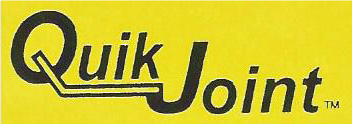Frequently Asked Questions - Asphalt Joint & Crack Sealing Tape
QJ Pavement Solutions Pty Ltd are the sole agent in Australia for the supply of QuikJoint Asphalt Sealer, Crack Filler and Repair tape. QuikJoint, commonly described as: Asphalt Crack Sealing Tape, Asphalt Joint Sealing Tape, Asphalt Repair Tape, Pavement Crack Sealing, Quikjoint Crack Sealing Tape, Asphalt Crack Repair Tape, Asphalt Crack Sealer, Bituminous Joint Sealant, Asphalt Pavement Sealer, Quikjoint Joint Sealing Tape.
Q1. Why seal cracks and joints in pavements?
A. It is widely accepted that sealing cracks and joints in pavements extends the life of the pavement by preventing the entry of water or dirt (and subsequent weeds), which would otherwise lead to degradation of the surface and creation of potholes. Sealing cracks with an appropriate asphalt crack repair tape soon after they appear, is a small investment for a longer term gain.
Q2. Why use QuikJoint Joint and Crack sealing tape?
A. QuikJoint is an asphalt crack sealing tape that has been manufactured in U.S.A. and been used extensively throughout America for over 20 years in a wide range of climates with great success. It is offers an wide range of benefits including, ease and speed of application, convenience, no waste, virtually no cleaning up (only removing the backing paper that is peeled off). It can immediately be applied to asphalt joints and the road, driveway or pavement can be be open to traffic soon after. Being a manufactured tape, QuikJoint gives a neat finish, of even thickness. No tracking. To ensure full adhesion of the asphalt pavement sealer, the surface must be dry and free of dust or dirt or loose material. QuikJoint is available in 2 widths, 50mm and 100mm.
Q3. How is QuikJoint Joint and Crack sealing tape cost effective?
A. Research indicates that, to minimise water infiltration, when repairing the crack, the crack be cleaned, filled with hot liquid asphaltic elastromeric material and then most importantly be overbanded with joint sealer. When using QuikJoint, an applicator is minimising labour costs and downtime.
An alternative method of crack and joint sealing commonly used entails the use of a tar kettle/hot box which begins at the depot by 2 men loading a hotbox onto a vehicle, and after transporting it to the job site, the same labour is required to unload it. They then have to wait until the materials are heated sufficiently before applying the bituminous joint sealant. Reheating may be required between jobs, and then there is the cleanup and reloading onto the vehicle.
The ease, speed and convenience of QuikJoint are outlined in the answer above. When applying QuikJoint crack and joint sealer tape in accordance with the instructions, job safety is also improved by minimising contact with hot tar and hot applicators.
Q4. Where can QuikJoint Joint and Crack sealing tape be used?
A. QuikJoint crack repair tape can be applied to concrete, bitumen or asphalt surfaces – that is, concrete to concrete, concrete to bitumen, concrete to asphalt, bitumen to asphalt, bitumen to bitumen and so on. It can also be applied vertically, although it is recommended you preheat the surface to help hold the tape in position before fully heating the asphalt joint sealing tape. Being a rubberised material, QuikJoint can handle both hot and cold climatic temperatures. You may lay asphalt over the asphalt repair tape.
Q5. What size cracks can QuikJoint crack sealing tape be used on?
A. QuikJoint sealing tape is not a structural tape – it has no fabric or membrane. It can be applied to cracks up to 3mm in width. For wider cracks, we recommend cutting strips of QuikJoint and after peeling the backing paper off, lay them into the crack until the crack is full, melt it with a blowtorch, then applying the tape over the crack. ALWAYS WEAR PROTECTIVE GLOVES WHEN NEAR OR HANDLING HOT MATERIAL. Other approved crack filling material may be used to fill the crack prior to applying the pavement crack sealing tape.
Q6. What other applications can QuikJoint bituminous joint sealing tape be used for?
A. Another application for this asphalt sealer tape is for anchoring road reflectors, also known as “catseyes”. Simply cut the required size, remove the backing paper, and burn onto the pavement surface then apply item whilst the tape is hot to ensure adhesion. ALWAYS WEAR GLOVES WHEN NEAR OR HANDLING HOT MATERIAL.
Q7. What is QuikJoint’s melting point?
A. The melting point of QuikJoint is 107 degrees centigrade. Contractors in Queensland advise us road temperatures reach the high 80’s C on hot days, so this is not a problem.
Q8. How is QuikJoint packaged?
A. QuikJoint comes in 2 widths, 50mm and 100mm. Being American the measurements are imperial, each roll being 50 feet long (15.24 metres). There are 8 rolls of the 50mm tape per plastic bucket (121.92 lineal metres), and 4 rolls of the 100mm per bucket, 60.96 lineal metres in total. The minimum orders we accept is 1 bucket.
Q9. Where is our warehouse?
A. Our stock is held in Mainfreight’s Sydney warehouse, so all deliveries are from Sydney, with bucket orders are sent by either Mainfreight or Startrack Couriers and pallet orders delivered by Mainfreight’s own trucks.
Q10. How can I place an order?
A. Orders may be placed by email sales@qjps.com.au or telephone 0416099080 with QJ Pavement Solutions Pty. Ltd. Once processed, we then give Mainfreight written authorisation to release the orders.
Q11. Can pallets of QuikJoint be mixed?
A. Yes. A pallet consists of 18 buckets, and may be made up to your requirements, for example 15 buckets of 50mm tape and 3 of 100mm. There can only be one width size per bucket.
Q12. What is the shelf life of QuikJoint?
A. We would hope that this would never be an issue as you will be frequently using the product. However the answer is infinite, if stored under 40 degrees centigrade. Do not store it against an exterior iron wall as it may get too hot. Always leave the sheets of paper separating the rolls, between the rolls so they do not stick together.
Q13. Does QuikJoint crack and joint sealing tape leach pollutants?
A. To reassure our many customers and councils there were no environmental or health issues pertaining to QuikJoint crack and joint sealing tape, we asked our manufacturing suppliers to have a lab test done by a credible, independent, internationally recognised and accredited laboratory to confirm this.
PRI Asphalt Technologies were recently engaged to, and to quote from the report, “Evaluate as-received hot applied crack/joint sealant for any H,S,and E (Health, safety and environment) potential issues and properties.”
The conclusion: The H,S, and E properties of the as received sample and TCLP leachate were observed to be non-problematic with no apparent Health, Safety or environmental concerns. Volatiles for received sample were found to be only 0.14g/L. No detectable PCB’s were found in the received material or the TCLP leachate. Metals were all in typically observed ranges with the exception of Magnesium at 1,018.9 ppm in the received material”.
When you look at PRI Asphalt technologies’ website https://www.priasphalt.com I am sure you will have confidence in their services, with their accreditations including AASHTO/AAP an ISO/IEC 17025 lab.
Unfortunately, as the report lists some of the “ingredients” of QuikJoint, we cannot provide a full copy of the report. However, please advise should a local authority or government department require further information in this regard.
QuikJoint is a registered trademark of Quikpave Inc.


